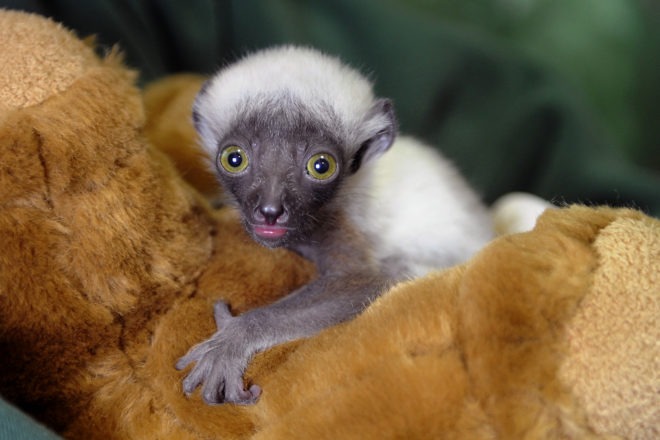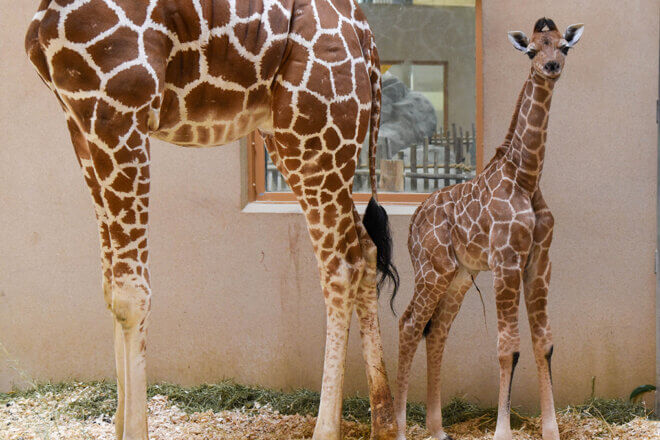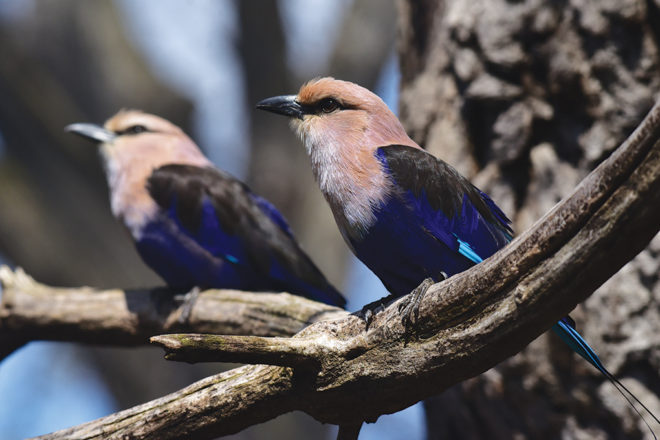BALTIMORE, MD — The Maryland Zoo in Baltimore is welcoming its newest arrival — a male Coquerel’s sifaka (CAHK-ker-rells she-FAHK) baby born on Tuesday, February 15, 2011. “This is a highly significant birth for the sifaka population in North America,” stated Mike McClure, general curator. “There are only eight accredited zoos that house the 50 Coquerel’s sifaka in the U.S. and this tiny baby represents 2% of the total captive population in the country.”
The Maryland Zoo’s sifaka pair, Anastasia, age 7 and Gratian, age 8 are the first time parents of baby Otto, which was born sometime between 9:00 am and 10:00 am on February 15. His birth weight was 100 grams, which falls in the average birth weights range of 85-115 g. “For comparison’s sake, 100 grams is just about the weight of a deck of cards,” said Meredith Wagoner, mammal collection and conservation manager at the Zoo. “Sifaka are born almost hairless and resemble tiny bald gremlins, however their white hair soon grows in and they begin to resemble their parents.”
Coquerel’s sifaka (Propithecus coquereli) are lemurs; native only to the island of Madagascar off the southeastern coast of Africa. Coquerel’s sifaka spend most of their lives in the treetops in two protected areas in the sparse dry, deciduous forests on the northwestern side of the island. As with many species of lemur, Coquerel’s sifaka are endangered — habitat loss due to deforestation is the leading threat to sifaka, as is the case with many species of lemur. Sifaka have a unique brown and white coloration, and are distinguished from other lemurs by the way that they move. They maintain a very upright posture and, using only their back legs, leap through the treetops. They can easily leap more than 20 feet in a single bound. On the ground, they spring sideways off their back feet to cover distance.
Newborn sifaka ride on their mother’s belly for the first month, then graduate to riding on her back. By two months of age they have learned the basics of leaping, and claim the treetops as their own by about six months of age. Young reach adult size at one year old. Coquerel’s sifaka reach sexual maturity at age 3 and when they do give birth, the litter size is always one. “Infant mortality is pretty high — about 1/3 of babies die in the first year,” said Wagoner, “So we have been monitoring Anastasia and the baby closely to watch for any signs of weakness. Fortunately, Anastasia is proving to be a very attentive mother and the baby is eating well and showing appropriate signs of growth.” Gratian has also taken an interest in the baby, although sifaka fathers do not closely assist with the childrearing.
Otto’s birth is the result of a recommendation from the Sifaka Species Survival Plan (SSP) coordinated by the Association of Zoos and Aquariums (AZA). SSPs provide breeding recommendations to maximize genetic diversity, with the goal of ensuring the long-term survival of the captive population and the health of individual animals. While keepers at the Zoo chose the name “Otto” for the Holy Roman Emperor Otto the Great, the theme of the Holy Roman Empire-esque names was the suggestion of specialists with the Duke Lemur Center in Durham, North Carolina, which owns the parents and directs the SSP breeding, studbook and husbandry protocols.
Zoo visitors will be able to see Otto along with Anastasia and Gratian in the sifaka exhibit inside the Chimpanzee Forest. “Right now he is clinging to Mom’s belly and blends in with her fur, but he will become easier to see as he grows,” concluded Wagoner. “Folks will still have to look high in the trees, but it’s worth the effort to catch a glimpse of this remarkable little guy.”






Share this article